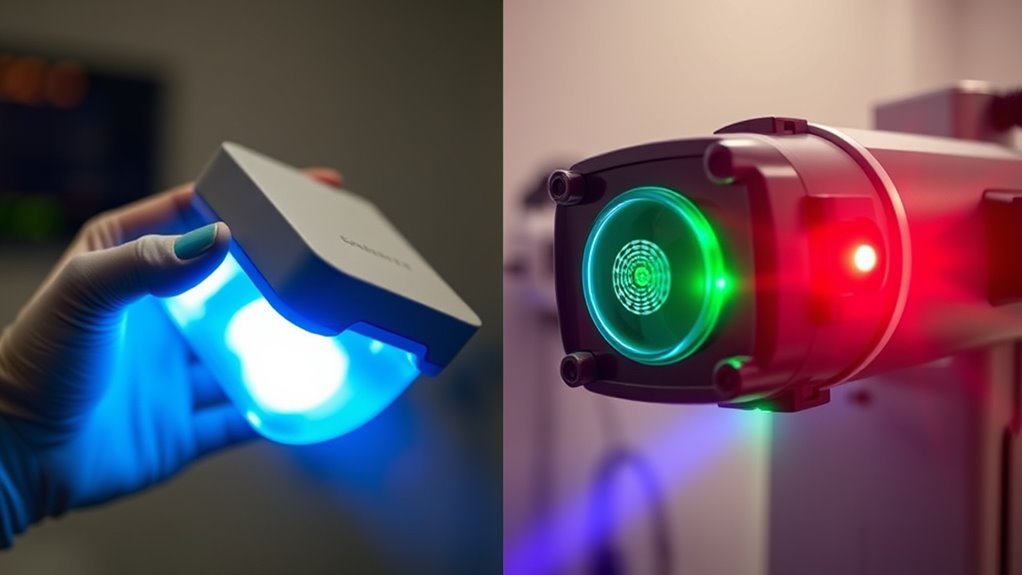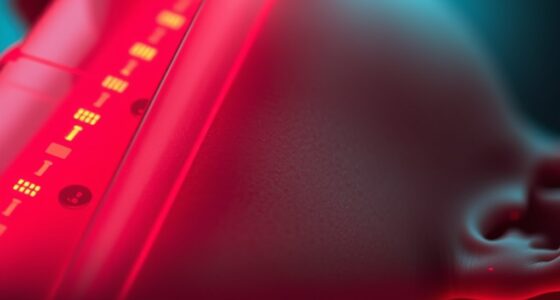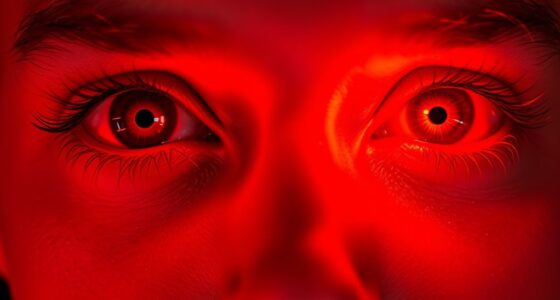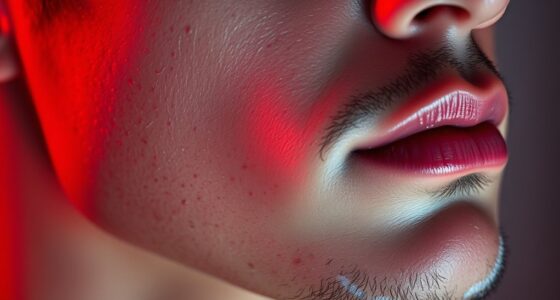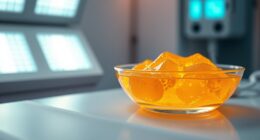Photobiomodulation and photodynamic therapy both use light but serve different purposes. With photobiomodulation, you benefit from specific wavelengths that activate cellular processes, promoting healing, reducing inflammation, and easing pain without damaging cells. In contrast, photodynamic therapy involves photosensitive agents that produce reactive molecules upon light activation, intentionally destroying harmful or diseased cells like cancer or infections. To understand how each technique works and their unique benefits, exploring further can shed more light on these therapies’ differences.
Key Takeaways
- Photobiomodulation uses specific light wavelengths to stimulate cellular functions without causing cell destruction.
- Photodynamic therapy involves a photosensitive agent and light to produce reactive molecules that destroy targeted cells.
- Photobiomodulation promotes healing and reduces inflammation, while photodynamic therapy aims to eliminate diseased or cancerous tissues.
- Photobiomodulation primarily enhances tissue repair and pain relief, whereas photodynamic therapy targets harmful cells for destruction.
- Both therapies utilize light but differ significantly in mechanisms, purposes, and outcomes.
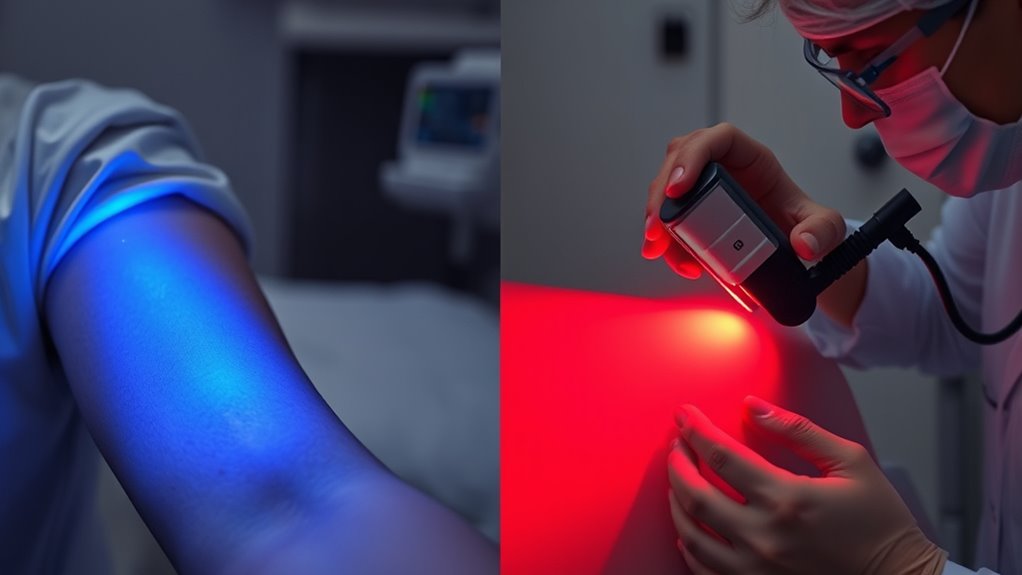
Photobiomodulation and photodynamic therapy are two innovative treatments that harness light energy to promote healing and combat disease. Although they both utilize light, they operate through different mechanisms and serve distinct purposes. Understanding these differences can help you make informed decisions about your healthcare options.
In photobiomodulation, the focus is on how light penetrates tissues to trigger cellular responses. When you use specific wavelengths of light, usually in the red or near-infrared spectrum, the light penetrates your skin and reaches deeper tissues. This penetration is essential because it allows the light to interact directly with your cells, especially within the mitochondria, which are the energy powerhouses of your cells. The cellular response involves increased production of ATP, the energy currency your cells use to perform fundamental functions. As a result, you may experience reduced inflammation, accelerated tissue repair, and pain relief. Photobiomodulation doesn’t rely on damaging or destroying cells; instead, it stimulates your body’s natural healing processes. Its applications range from managing chronic pain and reducing inflammation to enhancing wound healing and even supporting neurological recovery.
On the other hand, photodynamic therapy works differently. It involves administering a photosensitive agent, often a drug, which selectively accumulates in abnormal or diseased cells. When you expose these targeted areas to a specific light wavelength, the photosensitive compound becomes activated. This activation triggers a chemical reaction that produces reactive oxygen species—powerful molecules that can destroy cells. This process is especially effective in targeting cancer cells or infections, where the goal is to selectively eliminate harmful tissue without harming surrounding healthy tissue. Unlike photobiomodulation, which seeks to stimulate healing, photodynamic therapy aims to destroy or disable problematic cells. Its precision makes it a valuable treatment for certain cancers and infections, where targeted destruction is essential.
Frequently Asked Questions
Are There Any Side Effects Associated With Photobiomodulation or Photodynamic Therapy?
You might wonder about side effects concerns with photobiomodulation or photodynamic therapy, but overall, these treatments are considered safe. You’re unlikely to experience serious adverse effects, as both prioritize treatment safety. Some people may notice mild, temporary side effects like skin redness or sensitivity, but these usually resolve quickly. Always discuss your health history with your provider to guarantee the safest approach and minimize any potential concerns.
How Long Does Each Treatment Typically Take to See Results?
Like waiting for spring after a long winter, your results depend on the treatment type. Photobiomodulation often shows improvements within a few days to weeks, while photodynamic therapy may take several sessions over weeks to see noticeable results. The treatment duration varies based on your condition and response. Usually, you’ll start noticing changes in your result timeline as early as after the initial sessions, but full benefits might take longer.
Can These Therapies Be Combined for Enhanced Effectiveness?
Yes, you can combine photobiomodulation and photodynamic therapy to enhance results. Combined therapies often create synergistic effects, amplifying their individual benefits. This approach targets multiple aspects of healing or treatment, leading to faster or more holistic outcomes. Always consult your healthcare provider to guarantee the combination suits your specific needs and to determine the best protocol for your condition.
Are These Treatments Suitable for All Age Groups?
You might wonder if these treatments suit all age groups. Generally, they can be appropriate, but age suitability depends on developmental considerations. For children, special caution is necessary due to ongoing development, while adults typically respond well. For seniors, health conditions and overall resilience are factors. Always consult a healthcare professional to evaluate individual needs, ensuring safe and effective use tailored to each age and developmental stage.
What Are the Costs Involved in Each Therapy?
The treatment costs for photobiomodulation and photodynamic therapy vary based on location and provider, but generally, photobiomodulation tends to be less expensive. You might find that insurance coverage differs; some plans cover photodynamic therapy more often, especially for medical conditions. It’s best to check with your insurance provider beforehand to understand what treatment costs are covered and if you’ll need to pay out-of-pocket for either therapy.
Conclusion
Think of photobiomodulation and photodynamic therapy as two skilled artists, each wielding a different brush. One gently nudges your cells back to health like a calming sunrise, while the other acts like a precise laser cutter, targeting problems with pinpoint accuracy. Understanding their unique strokes helps you choose the right tool for your wellness masterpiece. With this clarity, you’re ready to paint a healthier, brighter future—one vibrant stroke at a time.
